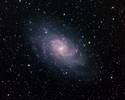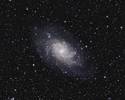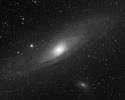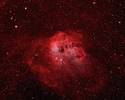Equipment - Vixen GP-D2
Vixen GP series mounts are widely regarded as the best mount in its price class. GP-D2 is the heftier one of these mounts having steel worm wheels and promise of greater tracking accuracy and load capacity. Most of the EQ-5 class Chinese mounts are clones of this Japan made mount.
I got mine in 2008 to replace my trustworhty Orion Skyview Pro. I was after better tracking for deepsky photography. Vixen delivered what promised, but having not the original Vixen steppers I just begged for problems...
At first I used the motors from my Orion Skyview Pro in the mount. The motors were poor mechanical fit to the mount but tracked quite well. There were some high frequency periodic error from the spur gears which made me thinking of better motors. Constant sigsawing from the spurs caused hard time to the autoguider.
I decided to go with MT-1 clones which had a similar casing as MT-1 and supposed to have the same features than original Vixen stepper motors. Mechanical compatibility is good but there was something going on. After changing the motors I couldn't get nice stars, but a little bit elognated ones in the direction of RA. At first I thought it is still the high frequency periodic error. These motors had even more teeths in the gears leading to increased frequency of the error.
A little research got me into Carsten Arnholms
webpage
where he described this high frequency problem with original Vixen MT-1 spur gears. He's solution was to use Astromeccanicas motors with belt and pulley drive. I didn't want to shop for new motors and cables etc. at this point so I started looking for a belt and pulleys to the existing setup. WarpsDrive was my choice. He makes a kit for the Meade LXD series mounts, which are clones of the Vixen GP series mounts. This made me believe Warps kit would also fit the GP-D2. I got nice set of pulleys and belts and little screws from Warp and was very hopeful to get things going right from now on.
I installed the belts and pulleys, reconfigured the Powerflex to the new RA Frequency due to the 32:30 transmission ratio of the pulleys and started to test the system. I noticed a smoother motions immediately, but something was still wrong and I decided to measure PE again. From the results I found a very steep drifting in the RA direction. And looking back the earlier results, I noticed it has been there before the Warps upgrade. All the gearing ratios were configured properly so something was going on. There was an error of about one percent in the drive speed, enough to PHD lose the star during 10 minutes of PE measurement. Not good.
I did a little thinking. Vixen must have their worm transmission ratio correct. That cannot be the problem. Also the WarpsDrive pulley transmission ratio had to be correct. One could count the teeths and confirm that. WarpsDrive also uses a timing belt to make sure the transmission ratio is what it is. PowerFlex MTS-3 should also be one of the most accurate stepper controllers, so we leave that out of the equation also. That leaves us the motors. I disassebled one of the motors and found a PFC42H-48081 stepper inside. That one should have 48 steps per revolution and the gearbox inside should have 1:120 transmission ratio. One of these must be wrong. I assumed the stepper step count must be the more reliable number based on how steppers are built. So the gearbox must have something other than 1:120 ratio.
I made a little experiment to try to figure out the problem and to make sure it is in the motors. I attached a laser to the motor, put the motor in a bench and programmed MTS to pulse the motor at 96 half steps per second. If the drive works as advertised, it should do 30 revolutions in one hour exactly. I marked a point in the wall, started a stop watch when the laser hit the mark and left it rotating. I came back after an hour and stopped the stop watch again when the laser hit the mark. 30 revolutions took 3628 seconds to complete, so the drive is confirmed to be the problem. I calculated a new transmission ratio of 1:120.95 and programmed the controller according to that and voila: the mount tracks perfectly now!
Images taken using Vixen GP-D2
2011

M33 - Finally there
09.10.2011 18:03 UTC: I think I've finally had enough with this galaxy. I tossed my last luminance data away due to hor... [Read More]

IC2118 - Looking for winter targets
28.09.2011 00:07 UTC: At the evening the weather was quite promisign and we decided to head into Tähtikallio. Unfo... [Read More]

M33 - LRGB Practising
27.08.2011 20:47 UTC: It's been long time since I've been out imaging for various reasons. We had a small star party or... [Read More]
2010

M31 - HaLRGB project starts from luminance
09.09.2010 20:54 UTC: We got a head start for the #1 star party in Finland, a Deepsky Meet in Artjärvi. It happene... [Read More]

M27 - Season opening test shot
16.08.2010 20:45 UTC: First night out after summer break I usually just test everything is still working and I still re... [Read More]

M13 - The Great Hercules Cluster
19.04.2010 23:07 UTC: After premature end with M106 I had a short opportunity to continue imaging before dawn. I could ... [Read More]

M106 Revisited
19.04.2010 20:10 UTC: I was in Artjärvi to try this again in a dark site. Unfortunately my exposures were cut shor... [Read More]

M101 - The Pinwheel Galaxy
18.04.2010 20:05 UTC: This beautiful galaxy was up high in the sky and weather was exceptionally good. This time I put ... [Read More]

M106 LRGB
12.04.2010 19:10 UTC: This is my very first try at LRGB imaging. I finally got Nebulosity to understand SX wheel via AS... [Read More]

IC410 - The Tadpoles Ha:OIII
23.03.2010 18:11 UTC: Not the best conditions for OIII imaging. Moon high up and random thin clouds hovering all over t... [Read More]

IC410 - The Tadpoles in Ha
17.03.2010 18:10 UTC: Spring sky is pretty much void in emission nebulae, but this nice complex in Auriga is still well... [Read More]

M81 Group and Integrated Flux Nebula
12.03.2010 18:03 UTC: Most of the Nebulae are illuminated by only one or just few stars. Integrated Flux Nebula is a la... [Read More]

M42 - The Orion Nebula
07.03.2010 17:32 UTC: Long time no see - stars! It's been like four months since I've done imaging. Weather has been ve... [Read More]
2009

The California Nebula project continues
22.11.2009 17:36 UTC: Finally after almost a month sky cleared again and what a night! SQM gave almost record readings ... [Read More]

The California Nebula
29.10.2009 20:10 UTC: After a long cloudy and rainy period we finally got some nice weather (and moon of course). I had... [Read More]

The Heart Nebula Project
07.09.2009 18:55 UTC: Finally I got some time and clear sky to do SII and OIII exposures to this. Moon was nearly full... [Read More]

The Heart Nebula Project
24.08.2009 19:51 UTC: I started my next project with H-alpha. This time my target is a nice nebula IC1805 commonly know... [Read More]

The North America Nebula
21.08.2009 20:10 UTC: Finally got my H-alpha filter and immediately had clear night to finish this project. Now totalli... [Read More]

The North America Project SII
19.08.2009 20:13 UTC: Clear sky allowed me to continue this project with SII data. Clouds disturbed the session a bit, ... [Read More]

The North America Project OIII
15.08.2009 20:13 UTC: I started my first astroimaging project for this season last night. The conditions were superb, s... [Read More]

M27 - The Dumbbell in OIII
09.08.2009 20:37 UTC: I continued to fine tune the system with M27 using OIII filter. I am getting pretty sharp results... [Read More]

NGC4565 - The Needle Galaxy
27.03.2009 18:55 UTC: The Needle, which is also known as The Flying Saucer Galaxy, is a very attractive spiral galaxy... [Read More]

M51 - The Whirpool Galaxy
26.03.2009 19:43 UTC: We have now clear nights after each other several days in a row now. This time I decided to imag... [Read More]

M101 - The Pinwheel Galaxy
26.03.2009 19:10 UTC: M101 is a very nice photogenic spiral galaxy in Ursa Major. The galaxy is positioned face-on and ... [Read More]

Leo Triplet
19.03.2009 18:26 UTC: Leo Triplet is a photogenic group of galaxies in the constellation Leo. This group is also known ... [Read More]

IC410 and The Tadpoles in color
08.03.2009 17:26 UTC: IC410 is a HII region in Auriga. This interesting nebula and open cluster hosts two interesting n... [Read More]

First light - IC410
07.03.2009 20:26 UTC: Atik 4000LE First Light! Weather was awful and I had some serious hassle with my gear. First of a... [Read More]

M42 - The Orion Nebula
09.01.2009 21:01 UTC: Very cold night. I haven't been out imaging in such a cold weather yet. Usually I don't take my g... [Read More]

Horsehead and The Flame Nebula
27.12.2008 20:52 UTC: It's been a long time since I was imaging last time. We have had a long cloudy period and wheneve... [Read More]
- M45 - The Pleiads @ 01.10.2008 18:34 UTC
- M31 - The Andromeda Galaxy @ 30.09.2008 19:24 UTC
- IC5070 - The Pelican Nebula (SII:Ha:OIII) @ 23.09.2008 18:01 UTC
- IC5070 - The Pelican Nebula (Ha:OIII:OIII) @ 06.09.2008 11:01 UTC
- IC5070 - The Pelican Nebula (Ha) @ 05.09.2008 15:55 UTC
- DWB111 - The Propeller Nebula @ 30.08.2008 08:38 UTC
- Nebulosity around Sadr @ 23.08.2008 07:10 UTC
- IC5146 - Cocoon Nebula @ 12.08.2008 07:12 UTC
- Partial Solar Eclipse @ 01.08.2008 19:01 UTC